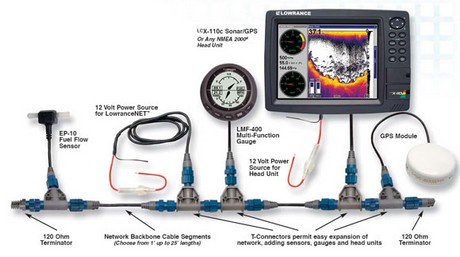LowranceNET NMEA2000, bad news, good news

Oy, I’m a tired puppy after 5 days of NMEA conference and yet more plane rides. Yesterday’s featured a puking infant during a bumpy landing in Boston followed by a final leg into Rockland on a little plane purposely run with some empty seats (they also rearranged us “for balance”, causing a wee bit more nervousness). But I am fully loaded with interesting info about NMEA 2000, AIS, new products and more, and I should be able to post more frequently, at least this week.
For starters, check out the NMEA 2000 “consistent” wiring system above introduced by Lowrance (more detail in a pop-up at Lowrance.com). It looks a lot like the standard NMEA 2000 cabling and connectors I’ve been testing but in fact it’s not certified and its plugs are purportedly not compatible! This is certainly not what the standard was supposed to be about—plug and play interoperability between different brands of gear—and I’m told it caused quite a hubbub in the NMEA 2000 committee meetings. (And I hope those folks who think NMEA is a “club” dedicated to keeping small developers out will note how fractious it really is). In fact there have been issues with the 2000 cable standard all along. Many think it’s too expensive and/or too bulky. That’s why Simrad, Raymarine, and Lowrance each use their own proprietary 2000 cable to interconnect their own 2000 equipment (which is legal under the standard). That’s why Simrad and Raymarine had to supply patch cables to tee into my test system (though I could have made them fairly easily).
So it would seem even messier if Lowrance sells an alternate, uncertified backbone cable/tee system—even if it leads to some of the first 2000 production boats, as announced by Ranger last week—but I’m told that there is going to be a happy ending to this story. Two reliable sources tell me that there will be a major breakthrough in the cable situation announced within a month. I’m guessing they mean that Lowrance will end up truly compliant and that the industry will agree on a second, less costly (though possibly more limited) cable and connector standard.













If Simrad and Raymarine have come up with their own versions of the standard that feature less expensive cables, yet take full advantage of the standard without limitations, why don’t folks at NMEA just adopt one of those designs as the new standard and be done with it? I’m sure hell will freeze over before anything like that happens, but it just seems to make sense.
Excellent question, with two possible answers. One is that the NMEA standard cabling is supposedly extremely resistant to physical abuse and electro magnetic interference (NMEA didn’t invent it; it’s called DeviceNet and it’s used a lot in industrial applications). One of NMEA’s goals was a wiring spec that could work no matter how close it ran near radar scanners, etc. (perhaps overcompensating for the weaknesses of NMEA 0183). The other answer I’d guess at boils down to: “How do you choose a 2nd wiring standard when 3 or more of your major players each offers its own (none of which have the track record of DeviceNet)?” At any rate, apparently some solution has been found, which sounds like good news for all of us NMEA 2000 enthusiasts.
Ben,
I was doing some research on cable and came across the following:
Maretron 5 meter NMEA 2000 cordset – $31.08 MSRP
http://maretron.com/products/pdf/200512.pdf
Simrad 5 meter Simnet/NMEA 2000 cordset – $42.00 MSRP
http://www.go2marine.com/g2m/action/GoBPage/id/99014F/simnet_accesories_data_cables_at10_and_tee_joiner_simrad.html
Raymarine 1.5 meter Seatalk2/NMEA 2000 cordset – $40.00 MSRP
http://www.raymarine.com/raymarine/ProductDetail.asp?page=1011&product_id=3119§ion=2
So it turns out that not only is NMEA 2000 cable better (waterproof and still operates while laying in bilge water, won’t come unplugged with a tug, better electrical shielding, etc.) it’s also cheaper than Simrad’s and Raymarine’s cabling!
A friend of mine just bought a pair of Evinrude E-TEC motors that boast NMEA 2000 compatiblitiy (they call it I-Command). I’m helping him put the NMEA2k system together. We’ve found that not only are the cablesets totally different from the NMEA standard, but some of the information that the motors send out over the NMEA2k network is only accessible with the the Evinrude branded NMEA2k guages (which, by the way, cost about 3x the Lowrance NMEA2k guages, and according to both companies, Lowrance manufactures the I-Command guages for Evinrude).
What the heck is the NMEA standard group doing? This has got to be the weakest “standard” out there…anyone can apparently claim to be NMEA2k compliant no matter what cablesets they use, in addition it seems that manufacturers can cherry pick “proprietary” data for their own branded electronics off this “standard” interface. What a crock.
What is the different between Lowrance LMF-400 and I-Command LCD? What�s missing in the LMF-400 that appears in the I-command display?
I�m going to buy 2 LMF-400 and connect to my Evinrude E-tec motor.
Stefan, I think you’ll find that LMF-400 will display all standard engine messages but not proprietary ones like diagnostics. The I-Com gauge also lets you control some engine functions, like instant winterization. I wrote more about this here:
https://panbo.com/yae/archives/001247.html